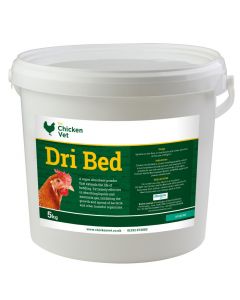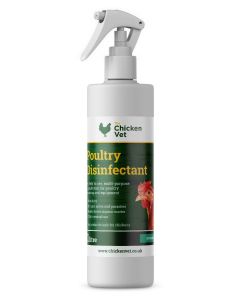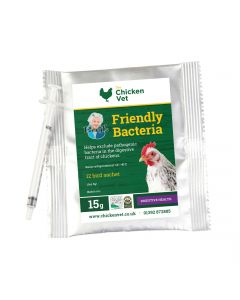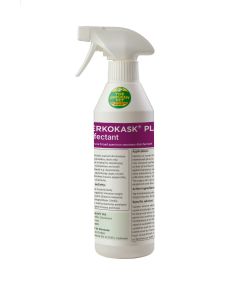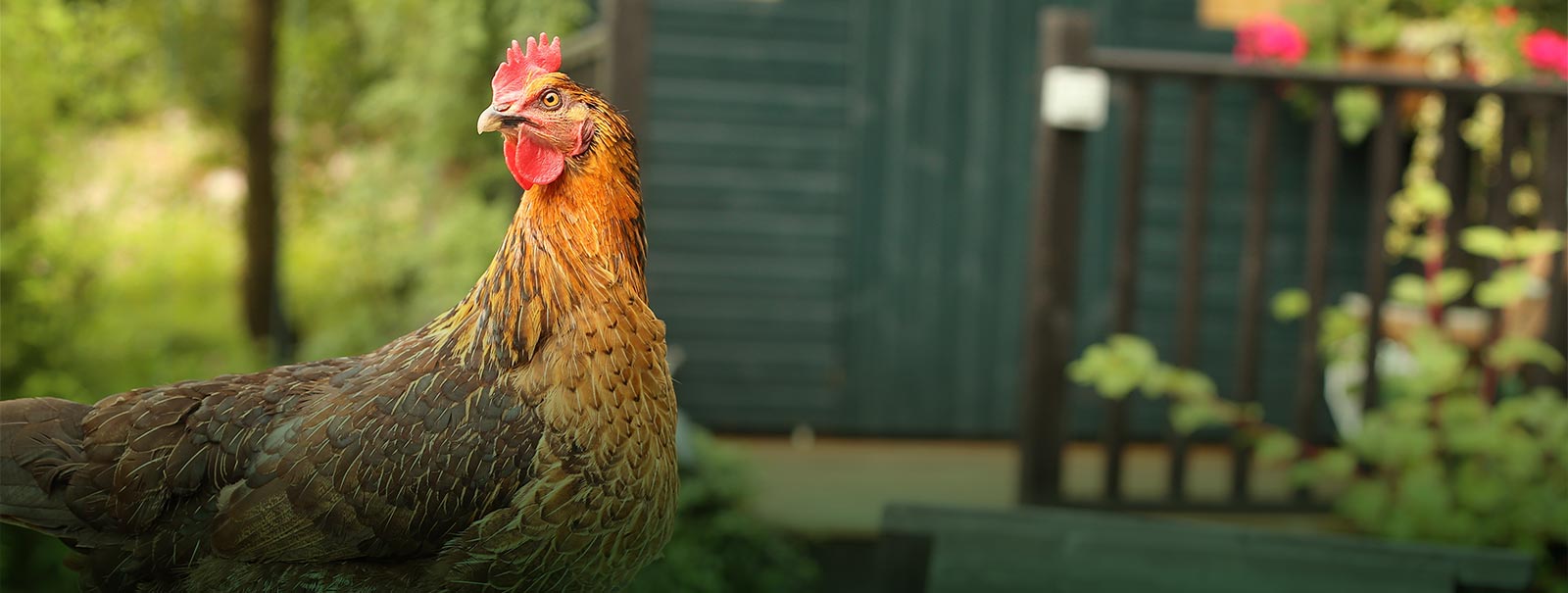
The advice hub Coccidiosis
When you find loose droppings in growing birds the first disease that springs to mind is coccidiosis. But what exactly is coccidiosis and how does it affect our chickens?
Coccidiosis is a parasite which damages the gut wall of young chickens before they reach maturity. There are a number of species of coccidiosis and their effects vary from harmless right through to life threatening.
Causes
There are six species of Eimeria (coccidiosis) which are generally considered to be significant for chickens: E. tenella, E. brunetti, E. necatrix, E. maxima, E. mitis and E. acervulina. Each of these species prefers to live in and damage a specific region of the gut. For the purposes of treatment and prevention of coccidiosis it is unimportant to ascertain which species is causing disease in your birds and in many cases several species may be working together to cause disease.
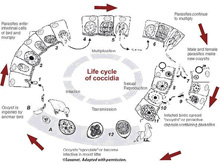
The lifecycle of coccidiosis is important to understand how to control this parasite. The life cycle starts with what is known as an unsporulated oocyst. Basically it is like an egg containing an early stage of coccidiosis which is yet to develop. In this state the oocyst is unable to cause disease if eaten. The oocyst sprorulates (develops so that it becomes infective) in as little as 24 hours under optimum conditions (a humid environment at 25-30ºC).
The oocyst has a thick wall which protects it from heat, cold and even common disinfectants. This enables coccidiosis oocysts to survive for up to several years and makes it difficult to destroy them.
When the sporoulated oocyst is eaten by the chicken, chemicals in the gut break down the oocyst wall and release the infective form of the coccidiosis called the sporocyst.
These sporocysts change into sporozoites which invade the cells of the gut wall and replicate. When the sporozoites have replicated in the cell, the cell bursts releasing another stage of coccidiosis called merizoites. These merizoites go on to invade and destroy more of the cells in the gut wall. Eventually the coccidiosis infection results in the production of more oocysts which are passed out with the faeces into the environment and can go on to infect other chickens. It is an extremely complicated cycle!
One of the problems with coccidiosis is that a single oocyst throughout its lifecycle can end up destroying several thousand gut cells. If a chicken eats a few oocysts and only a few thousand cells in the gut are destroyed then the chicken will not have any ill effects and will go on to become immune to coccidiosis. However if the bird eats large numbers of oocysts then millions of cells in the gut are destroyed. This causes pain for the birds, they may stop eating adopting a hunched posture with ruffled feathers. The damage to the gut wall reduces the ability of the gut to absorb nutrients resulting in weight loss and diarrhoea. In severe coccidiosis especially where E. tenella is involved the damage to the gut wall can be so severe that the bird bleeds into its gut causing blood in the bird’s droppings and anaemia characterised by a pale comb and wattles.
This gut damage can also disrupt the natural balance of bacteria in the digestive tract thereby allowing harmful bacteria to take over and cross the damaged gut wall causing blood poisoning.
In an ideal situation chickens exposed to low levels of coccidiosis will build up a natural immunity. What often happens is the first few chickens in the flock are exposed to a few oocysts and build up immunity, however these birds act as coccidiosis factories and produce millions of oocysts which can go on to infect their flock mates. If the pen is not cleaned properly after that batch of birds leaves the pen then the next batch are exposed to high levels of coccidiosis and suffer the adverse effects.
In general, immunity is not given from the hens to their chicks and the chicks will get exposed to coccidiosis in the first few weeks of life and will go on to develop immunity with or without clinical disease. One group of chickens which do not develop this immunity are ex caged hens as they are not exposed to their own faeces. When these birds are rehomed at the end of their flock life they suddenly become exposed to coccidiosis and then can go on to develop clinical signs.
Treatment
Treatment of coccidiosis generally involves three components.
- Kill the coccidiosis in the birds to stop further gut damage, this usually involves an anti-coccidial medication which can only be obtained following diagnosis through a vet.
- Levels of coccidiosis can be detected if you send Chicken Vet a sample using a Chicken Vet Worm Egg Kit as the testing also covers coccidiosis.
- Control the bacterial disruption to the gut, this is treated by antibiotic therapy.
- TLC, providing your bird with a warm dry environment and following any medication advice. It is advisable at this stage to follow on with provision of Multivitamins and a probiotic to restore gut flora with a product such as Beryl’s Friendly Bacteria.
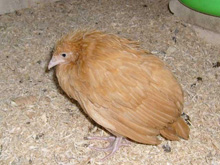
The most important thing is to ensure that the shed is properly cleaned and disinfected to remove and destroy the coccidiosis oocysts. This involves removing the old litter, using a detergent to remove dirt and grease so that the disinfectant can work and finally using a disinfectant such as Interkokask or Chicken Vet Poultry Disinfectant. The concentrate formulation of Interkokask is DEFRA approved and licensed to kill oocysts, many commonly used disinfectants are unable to kill the oocysts and will not be suitable for killing coccidiosis. Reducing the risk of your young flock being exposed to large numbers of oocysts and their immune systems being overwhelmed is essential.
When your birds are placed the next step is to stop too many oocysts sporulating (developing to become infective) at once. As stated above oocysts develop under warm damp conditions quickly. Whilst your young birds need heat and we can’t take that away from them, we can control the humidity. This involves having good ventilation and keeping the bedding dry, this may involve topping up the bedding or using drying agents such Chicken Vet Dri Bed.
For most backyard producers the above steps should be sufficient to prevent disease outbreaks however in larger scale holdings, medication can be used to control coccidiosis. This involves post mortems and examinations before treatment can be prescribed. Whilst these may sound better, they do not allow immunity to develop and should only be used during disease outbreaks. This medication is a Prescription Only Medication (POM-V) which means you should only use it under the guidance of your prescribing veterinary surgeon and it is also not licensed for use in laying birds. This means your vet has to prescribe it under the rules of the Veterinary Medicines Directorate cascade. If it is prescribed to laying birds you will have to follow strict rules of withdrawal of eggs for your own consumption and you must not sell your eggs for human consumption following use of this.
A vaccine is available commercially, however its administration can be complex and needs the correct environment to work, realistically this is not currently practical for backyard chicken holdings.
Finally, other poultry can be infected by coccidiosis however each species of poultry have their own species of coccidiosis that infect them. For example the chicken coccidiosis species will not cause disease in turkeys or geese and vice versa. The optimum conditions for coccidiosis to develop in chickens are the same for coccidiosis in turkeys so the control and prevention are as described above.
If you are concerned about coccidiosis then consult your vet. We offer a Chicken Vet Faeces Sample Kit, whereby you collect some droppings from your birds and send them to the Chicken Vet laboratory, the droppings are tested for coccidiosis and worm eggs and you will receive your results within 48hrs.

